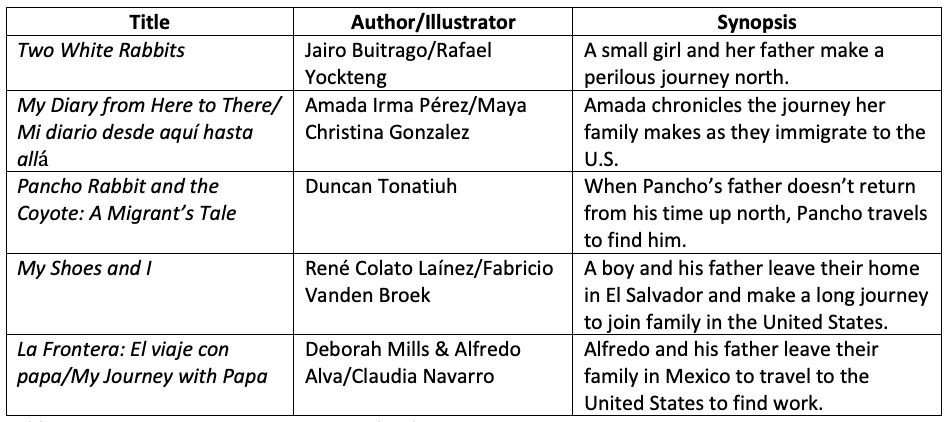By Janine M. Schall, University of Texas Rio Grande Valley, Edinburg, TX
This month in WOW Currents my colleagues and I discuss various aspects of children’s literature that features Latinx characters and settings. The Latinx population in the United States has grown dramatically and Latinx people now make up about 20% of the U.S. population. Yet this group remains underrepresented in the media, including children’s book publishing.
Latinx immigrants are often demonized in the media today and used to score political points by politicians and others who ignore the complicated reasons people make the difficult decision to leave their homelands and the human cost entailed in their journeys. While this skewed perspective on Latinx immigration paints immigrants as criminals or ignorant drains on society, the reality is that most immigrants are utilizing strong networks of knowledge and community as they make the best decisions they can for themselves and their families within a constrained set of choices.
All children need opportunities to explore issues related to refugees and immigrants; for some children this is their lived experience while for others it is part of learning about the world. Recent years have seen the number of books featuring immigrant or refugee characters increase in number. Many of these deal with how an immigrant child adapts to a new country or language. A smaller set of books share stories of the immigrant journey, and it is these books that I discuss below. This post comes out of a larger research project on Latinx immigrant journey picturebooks conducted with my colleagues Jeanne Fain and Julia Lopez-Robertson.
My colleagues and I are examining children’s picturebooks that tell stories of how Latinx characters immigrate from Latin America to the United States. There are only a handful of these Latinx immigrant journey picturebooks, including those in Table 1. While these books provide rich opportunities for discussion and thinking about the world, I focus on two particular ideas that cut across each book in this set: agency and community.

Table 1: Latinx Immigrant Journey Picturebooks
Rather than being ignorant, these books position Latinx immigrants as knowledgeable, competent and in charge of their own lives. The characters make strategic, agentic choices before and during their journeys, beginning with the reasons they decide to leave their homes. We see this decision three separate times in Pancho Rabbit and the Coyote: A Migrant’s Tale. First, Papá and his friends leave the village to find work up north when drought leaves their own fields barren. Next, Pancho goes north in search of his father, who has not returned home when expected. Finally, Papá and the family decide that they will travel north together if the poor economic situation persists. Economic reasons also lead to the decision to immigrate in My Diary from Here to There and La Frontera: El viaje con mi papa, while in My Shoes and I the boy and his father are going north to reunite the family. Each set of characters also carries with them important sets of knowledge, such as how to navigate the U.S. immigration system to obtain green cards, how to access community and experiential immigration networks to support their journeys, and how to build and maintain mutually beneficial relationships along the way. These are not hopeless and helpless people; rather, they make thoughtful choices and take action under stressful and often dangerous circumstances.
The immigrant journey in these books is a community and family event. The decision to immigrate is often linked to the desire to economically support the family. In addition, the immigration experience occurs within a family context as some family members travel together while others are waiting to be reunited. The community, too, is part of the immigrant journey experience. In Pancho Rabbit and the Coyote and La Frontera: El viaje con papa the town gathers together for a going away party. An extended immigrant community is also shown in several books, notably Two White Rabbits, where groups of immigrants gather together as they wait for the next stage of their journey. Clearly, immigration is not an independent, solo activity but an event that takes full advantage of social relationships that can support the immigrant before, during and after their journey.
These books are honest and realistic about the immigrant journey and it would be possible for readers to focus on the difficulty and hardship that the characters experience. While the difficulty of immigration should not be glossed over, young readers should also be helped to see the strength of the immigrant characters, the agency they act with and the strong community and social bonds that sustain them.
Next week we continue discussing Latinx children’s books. Maria Leija will talk about using interactive read alouds in an immigration unit. After that, Gilberto Lara will focus on Latinx children’s books with characters who do not conform to expected gender roles. Finally, I conclude by sharing holiday books that feature Latinx characters.
Do you have other examples of immigrant journey picturebooks? If so, please share them in the comments!
Children’s Books Cited
Buitrago, J. (2015). Two White Rabbits. Berkeley, CA: Groundwood.
Colato Laínez, R. (2010). My Shoes and I. Honesdale, PA: Boyds Mills Press.
Mills, D. & Alva, A. (2018). La Frontera: El viaje con mi papa/My Journey with Papa. Cambridge, MA: Barefoot Books.
Pérez, A. I. (2002). My Diary from Here to There/Mi diario desde aquí hasta allá. San Francisco, CA: Children’s Book Press.
Tonatiuh, D. (2013). Pancho Rabbit and the Coyote: A Migrant’s Tale. New York, NY: Abrams.
Journey through Worlds of Words during our open reading hours: Monday-Friday, 9 a.m. to 5 p.m. and Saturday, 9 a.m. to 1 p.m.
- Themes: Janine Schall, Latinx Children's Books
- Descriptors: Books & Resources, WOW Currents
